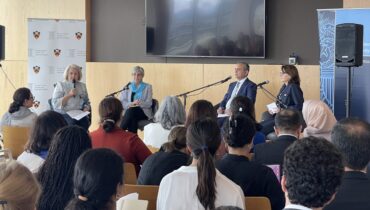On September 30, 2022, a suicide bombing took place at the Kaaj Educational Center in Kabul, which was packed with hundreds of students preparing for exams. The attack took the lives of 54 young female students, largely from the Hazara minority community. Afghans of different ethnicities joined the Hazara people in condemning the atrocities and calling for the protection of and justice for Afghan women, girls, and minorities.
This tragedy is the latest in a string of targeted attacks on schools, mosques, and other public spaces perpetrated by the Taliban and other extremist groups. Attacks impact all Afghan communities, but those on Shiite places of worship and community centers, and toward the Hazara community in particular, have been frequent and systematic.
This attack underscored the targeting of Afghans based on their gender and ethnic identities, and the overlapping disadvantages of poverty, restrictions on education, and increased security threats at educational institutions. It is one of the most dramatic examples of how the Taliban’s draconian rule, and the violence it begets, is erasing the futures of young Afghans across the country. It also serves as a stark reminder of the international community’s failure to protect civilians and uphold international human rights in Afghanistan.
Extensive consultations with security experts and Afghans directly exposed to the Kaaj Educational Center attack revealed that the tragedy was largely preventable, and casualties could have been minimized. The Kaaj Educational Center had multiple vulnerabilities that are characteristic of poorly resourced educational and community centers across Afghanistan. The international community must heed these lessons learned to protect Afghan students and prevent future attacks.
Policy interventions should focus on addressing the following:
- Weak or absent security measures/equipment: Many educational centers where explosions have occurred lack trained security security cameras, double deterrence entrances, and safe rooms, as well as basic body searches and identity checks at school gates. Security guards at the Kaaj Educational Center, for example, were easily killed as they were not equipped with proper weaponry.
- Failing infrastructure/insecure buildings: Many school buildings are old or rented commercial or residential spaces that lack standard entrances or exits, making them difficult to secure. Some private universities that remained safe despite threats had strict security measures, including security equipment and emergency exits.
- Under-resourced schools or lack of experienced security personnel: Education centres forced to run on student fees, especially those operating in low-income Hazara areas, cannot afford experienced security employees and sufficient security measures. If there are security guards, they are often ordinary civilians who lack basic training and experience in the protection and security sector.
- Lack of emergency preparedness and protocols: Afghan schools do not have emergency warning alarms or protocols to prepare people on the premises for an incoming attack, or training on how to seek safety in case of an emergency. At the Kaaj Educational Center attack, a teenage girl close to the attackers survived with minor injuries – unlike others near her – because she was trained by her father to lay down during an attack or gun fire. During the explosion in Seyed al-Shohada girls’ school, another girl who had been trained by her uncle who was in the army threw herself under a desk and survived despite close proximity to the explosion.
- Barriers/restrictions to emergency aid response: The Taliban prevented aid workers from entering the strike zone after the Kaaj Educational Center attack, and interrogated and threatened people who launched campaigns to support the wounded. This undermined life-saving actions that Afghan communities across ethnicities historically take to respond to attacks, including mobilizing support and voluntarily donating blood. For example, Pashtun and Tajik women provided their urgent cooperation for the wounded girls of Seyed al-Shohda school and cooperated quickly in getting passports to send victims abroad for treatment.
In addition to these vulnerabilities, attacks are also difficult to detect for the following reasons:
- Events suggest that perpetrators use different strategies and tactics to go undetected before attacks. For example, they wear local clothes to blend in or pose as officials in uniform. They also use attackers that appear ethnically ambiguous and therefore less easily identifiable.
- In most cases, the density of students makes it hard to closely watch each person entering the educational facility. Sometimes, explosive devices are placed in the most crowded areas and remotely detonated. Other times, attackers strike students during dismissal from school or pick a crowded place where they are difficult to identify. Perpetrators sometimes attack in several phases, such as the attack at Syed ul Shahada High School. After the first attack was committed, they attacked again when people gathered to help the injured and victims, increasing the casualties dramatically.
Policy Recommendations:
We recommend that UNAMA and other national and international organizations that focus on human rights and civilian protection in Afghanistan take the following actions to bolster prevention measures and strengthen the protection of Afghan students:
- Form a formal security strategy committee to secure educational facilities and schools. This should be composed of Hazaras, other minority groups, and internal security experts, to devise a security policy and set of recommendations that will help reduce risk and mitigate current
- Ensure adequate financing and budget allocation, across both UNAMA and INGOs, for the provision of security measures to schools and educational centers in high-risk places. These provisions should include secure and anti-impact gates, security cameras, and equipped building safe rooms.
- Increase support for security training and community policing at educational sites, as well as help with assessing building security.
- Strengthen collaboration to enhance security measures and attack response efforts. UNAMA and other agencies should support drafting a plan that closely coordinates education protection with Taliban authority and local Any restrictions on direct community support should be lifted at the time of an attack for swift action that can save lives.
- Apply coordinated pressures on the Taliban to protect schools and educational centers. The offices of UNAMA, USAID, and the U.S. State Department should demand increased safety measures in negotiations and talks with the Taliban. This includes Taliban cooperation to allow armed security officers at schools and educational centers.
- Ensure all aforementioned recommendations prioritize adequate resourcing and attention to the specific vulnerabilities of minority communities.


